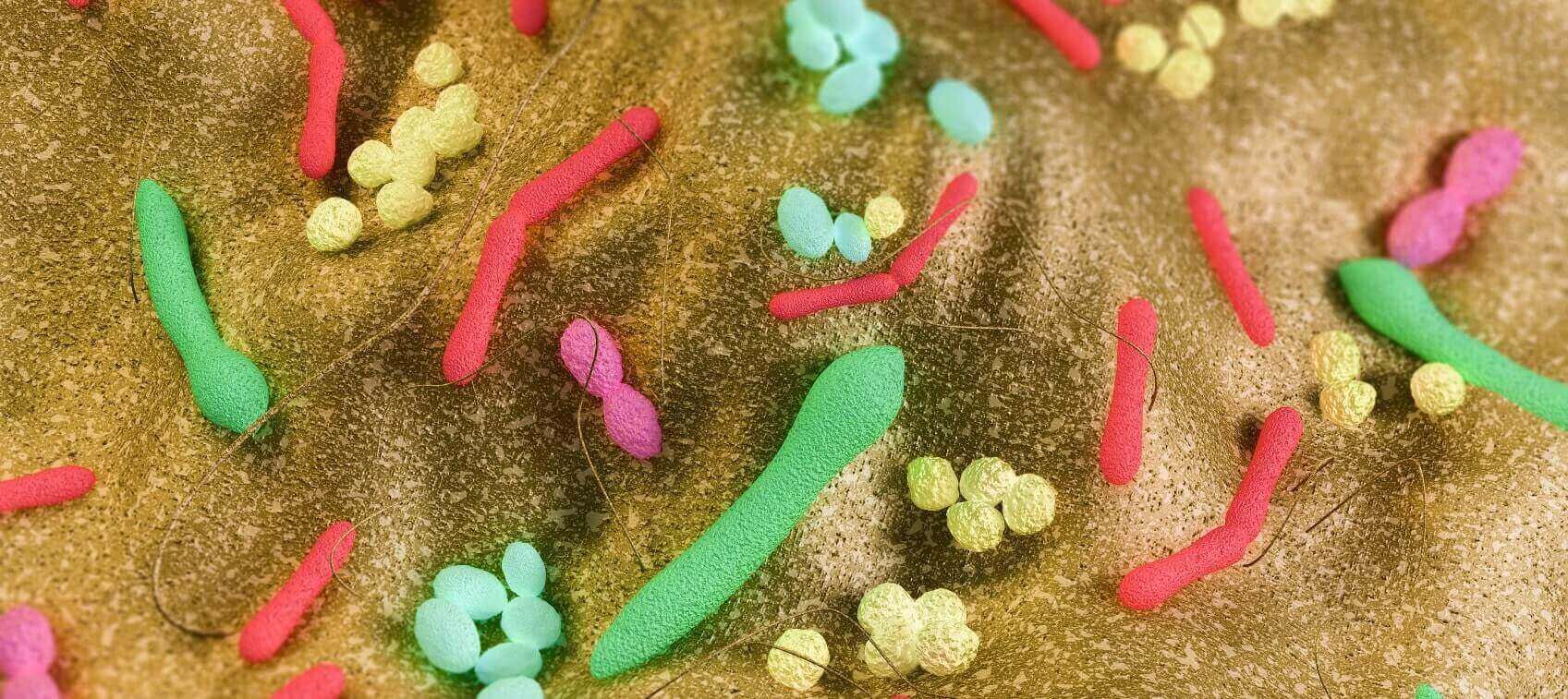
From a young age, we’re taught that germs are gross and cause people to get sick, and in general as a culture we fear them. This fear of germs actually concerns me because many Americans are overusing sanitizing wipes and soaps, overusing antibiotics (for ourselves, and also livestock), eating too many sterilized foods and not enough fermented (bacteria and yeast rich) foods, and we stay indoors too often preventing natural exposures to the vast assortment of bugs in our environment.
Yes, there are of course “bad” bugs that can make us very sick, and these we certainly want to avoid and protect against. But, the majority of bugs are “good” ones that help build our microbiome, support our immune system, and protect us against other bad bugs. What we really need is balance.
Science is proving that regular exposure to bugs helps build our microbiome and modulate our immune system. What this means is that being in contact with bacteria, yeasts, and other microorganisms is essential for our health; without these exposures we may be at risk for developing certain illnesses.
Take for example the study from Zurich, Switzerland looking at pregnant women and exposure to farm animals: Researchers found that pregnant women who spent their time in proximity to farm animals and cats gave birth to children who developed less atopic dermatitis (i.e. eczema) in the first two years of life compared to controls (no animal contact). In this study, more exposure to animals lead to greater exposure to bacteria and other microbes, which helped train the developing baby’s immune system.
I hope after you read this article that you’ll be more accepting of microbes and understand how they can in fact support our bodies in many different ways.
Components of the Microbiome
Bacteria and yeasts and other organisms are ubiquitous throughout our environment, and they are also found all over our bodies including our skin, sinuses, eyes, lungs, and digestive tract. It may sound disgusting to learn that bugs are found throughout our bodies, but it’s true, and they are absolutely essential for our survival.
The gut microbiome is really the hub where most of these organisms are found, and in fact it’s estimated that the large intestine is home to trillions of bacteria! That’s approximately 10 times the number of cells in your body. The gut microbiome is also home to yeasts, protozoa, viruses, and other organisms. These organisms play a vital role in keeping you healthy.
From the moment a baby is born, particularly if born vaginally, exposure to germs is truly unavoidable unless confined to a sterile bubble. But these exposures are a good thing, and the immune system needs to be in regular contact with bugs to develop properly. The gut microbiome in particular needs regular exposure to bugs to help create immune tolerance, which is essential for a healthy immune system.
In general, the gut microbiome can be broken down into two main components: the Bacteriome and Mycobiome.
The bacteriome is the component of the microbiome that is made up entirely of bacterial organisms. These include thousands of species of bacteria that you are probably familiar with such as lactobacilli and bifidobacteria. It’s home to many of the soil-based organisms (or spore-forming bacteria) such as Bacillus coagulans and Bacillus subtilis. The Bacteriome also contains a vast array of other bacteria that are normal inhabitants of the gastrointestinal tract.
The mycobiome is the component of the microbiome that is made up entirely of yeast/fungi organisms. Like bacteria, there are a number of yeast organisms that are normal inhabitants of the gastrointestinal tract. The Mycobiome refers to these fungal organisms as the root “myco” which is derived from the Greek work for fungi. Over 50 genera of fungi have been commonly reported in the GI tract, and around 10 genera make up the majority of the mycobiome. Two common genera that are found in the gut include Candida and Saccharomyces.
Functions of the Bacteriome and Mycobiome
Chances are, you’re already familiar with the role bacteria play in gut health—there are many different strains and supporting this diverse flora is key. Feeding these multiple types of strains can be more beneficial and effective than supplementing with just a few strains.
Among many functions, the bacteria in the gut are responsible for the following:
- Help break down foods to make nutrients more easily absorbable
- Help produce vitamins like Vitamin B12, Folate, and Vitamin K
- Help maintain the integrity of the mucosal layer (i.e. prevent leaky gut)
- Help build and support and a healthy immune response
- Help play a major role in the communication network with the brain (e.g. gut-brain axis)
We know that supplementing with different strains of bacteria like lactobacilli and bifidobacteria can help improve many digestive parameters like gas and bloating, regularly of bowels, and abdominal pain. Research is also showing us that supplementing with certain strains of soil-based organisms (bacillus) can achieve similar benefits and can have far reaching impacts on the rest of the body including influencing skin health, and even mood!
Recently, research has come out showing how yeasts in the gut influence health. Just as the bacterial inhabitants (the bacteriome) play a role in influencing immune function, digestive health, and metabolism, we are discovering that yeasts also interact with many of these same physiological processes and interact with bacteria and other organisms that make up the intestinal flora.
Several species of yeast have been found to have probiotic properties. Two well-known yeast probiotics include Saccharomyces boulardii and Saccharomyces cerevisiae. Specific strains of each of these yeast species have been cultivated because they exhibit properties making them well suited for probiotic applications. Just as supplementation with probiotics improves the overall bacterial balance of the GI tract, supplementing with healthy yeast can improve the overall balance of yeast in the digestive tract by removing less healthy species.
Goal: Increase Diversity of the Gut Microbiome
A more diverse gut is a healthier gut. That means we need the right balance of bacteria, yeast, and other organisms. Fortunately, there are many ways to achieve this.
When there is an imbalance of gut flora, dysbiosis can form. Dysbiosis means that too many or too little gut bugs are present, and this can lead to all sorts of problems including GI related issues and even systemic issues like joint pain. The goal is to create balance by supporting diversity of bugs along the GI tract.
Here’s what you’ll want to do to prevent dysbiosis and promote and increase diversity of microbes in the gut:
- Avoid overuse of medications like antibiotics, corticosteroids, and heartburn medications (e.g. proton pump inhibitors).
- Avoid sugar and processed foods that lead to yeast and bacteria overgrowth
- Reduce stress as best as you can (easier said than done, right?).
- Eat a diet rich in fruits and vegetables, which are high in fiber. Fiber acts as fuel to support a healthy vibrant microbiome and helps cleanse the bowels.
- Eat and drink an assortment of fermented foods/drinks. These include sauerkraut, kim chi, beet kvass, yogurt, kefir, miso, pickled vegetables, kombucha, etc.
- Eat organic foods and drinks as pesticides and other chemical residues may harm gut flora.
- Choose to eat organic pasture raised animals instead of conventional factory farmed animals. Factory farmed animals are often given antibiotics prophylactically and are pumped up with hormones to produce greater yields in meat.
- Filter your drinking water to reduce exposure to chlorine and other chemicals.
- Take a broad-spectrum probiotic that contains bacteria (lactobacilli, bifidobacteria, bacillus) AND yeast (saccharomyces boulardii and cerevisiae)
- Get outside more, take hikes through the woods or on the beach, walk barefoot, garden and get your hands in the soil, and if you have kids don’t worry if they get muddy at the park.
Resources:
https://www.sciencedaily.com/releases/2010/12/101202124215.htm


